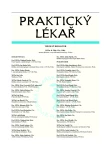Nosocomial infections
Authors:
B. Čečetková 1
; Z. Kancelová 1; R. Chlíbek 2
Authors‘ workplace:
Fakultní Thomayerova nemocnice, Praha
Oddělení hygieny a epidemiologie
Vedoucí: MUDr. Zuzana Kancelová
1; Fakulta vojenského zdravotnictví Univerzity obrany
Hradec Králové
Děkan: plk. doc. MUDr. Roman Chlíbek, Ph. D.
2
Published in:
Prakt. Lék. 2010; 90(3): 152-156
Category:
Various Specialization
Overview
Nosocomial infections (NI) lead to an extension of hospital stay, an increase in treatment costs and an increase in general hospitalisation expenses, as well as increasing the time the patient is out of work. NI represent a severe public health problem. Hygienic-epidemiological treatment is focused mainly on the frequent infections, or infections with the serious consequences for the patients. The main step towards implementing the efficient precautions is the adequate surveillance, as the complex epidemiological approach consisting of active monitoring, analysis of the relevant information concerning infection characteristics and spread, including feedback leading to the practical measurements in the given workplace. NI precautions in the general practitioner’s office should implement its specifics. Mainly the short contact with the patient could lead to the undervaluation of the NI risk, as most of the NI is developed consequently, during the after-care or the hospitalisation. Every health professional should know basic information concerning NI, precaution and related legislation.
Key words:
nosocomial infections, agents of infections, source of infections, transmission of infections, anti-epidemic precautions, surveillance.
Sources
1. Arrowsmith, M. Chirurgické ranné infekce. Klin. mikrobiol. inf. lék. 1999, 5(4), s. 135-137.
2. Bencko, V., Kapek, J., Vinš, O. Hospital waste treatment and disposal in the General University Hospital – current situation and future challenges. Indoor Built. Environ. 2003, 12(1/2), p. 99-104.
3. Čečetková, B., Kancelová, Z. a kol. Prevalence studies on nosocomial infections in 10 university hospitals in the Czech Republic. International Scientific Exchange, ISID, 2008, p. 86-87.
4. Čečetková, B., Girod Schreinerová, M. a kol. Metodika pilotní prevalenční studie NN. Praha: SZÚ, 2009. Dostupný http://www.szu.cz/pilotni-prevalencni-studie-vyskytu-nemocnicnich-infekci.
5. Haley, R.W., Culver, D.H., White, J.W. et al. The efficacy of infection surveillance and central programs in preventing nosocomial infections in US Hospitals (SENIC). Am. J. Epidemiology 1985, 121, p. 182-205.
6. Havlík, J. a kol. Infekční nemoci. Praha: Galén 2002.
7. Horan, T.C., Gaynes, R.P., Martone, W.J. et al. CDC definitions of nosocomial surgical site infections, 1992: a modification of CDC definitions of surgical wound infections. Am. J. Infect. Control. 1992, 20(5),: p. 271-274.
8. Kolářová, M., Šrámová, H. a kol. Nemocniční hygiena a epidemiologie; příspěvek k surveillance nemocničních infekcí. Zprávy CEM (SZÚ, Praha) 2006,; 15(5), s. 212–214.
9. Maďar, R., Podstatová, R., Řehořová, J. Prevence nozokomiálních nákaz v klinické praxi. Praha: Grada Publishing 2006.
10. Podstatová, H. Hygiena provozu zdravotnických zařízení a nová legislativa. Olomouc: EPAVA, 2002.
11. Schejbalová, M., Bencko, V. Historie, současné problémy a šance v prevenci nozokomiálních nákaz. Prakt. Lék. 2008, 88, 5, s. 293-295.
12. Šrámová, H. a kol. Nozokomiální nákazy II. Praha: Maxdorf Jessenius, 2001.
13. Wenzel, R. Infection control in the hospital. Boston: ISID, 2008.
Labels
General practitioner for children and adolescents General practitioner for adultsArticle was published in
General Practitioner

2010 Issue 3
- Metamizole vs. Tramadol in Postoperative Analgesia
- Memantine in Dementia Therapy – Current Findings and Possible Future Applications
- Metamizole at a Glance and in Practice – Effective Non-Opioid Analgesic for All Ages
- What Effect Can Be Expected from Limosilactobacillus reuteri in Mucositis and Peri-Implantitis?
- Hope Awakens with Early Diagnosis of Parkinson's Disease Based on Skin Odor
Most read in this issue
- Nosocomial infections
- Migraine and epilepsy comorbidity
- Aseptic meningitis as a manifestation of HIV primary infection
- Basal cell carcinoma of the skin – the most important risk and prognostic parameters of disease in clinical practice
